SD you are obviously a Rotax evangelist and that is your right but when I commented in another thread that I liked the simplicity of the Jabiru engine compared to the complexity of the Rotax 9 series you disputed this. I mentioned that the failure rate of Rotax engines is actually higher than for Jabiru engines in Australia in 2023 plus a catastrophic failure in a Sling locally. I thought that would be like a red rag to a bull but no not a peep. I don't care that there are Rotax engines with 2. 3, 4 ,000 hours on them. Plenty of jab engines make the 2000 hour TBO as well. None of these I would guess are owned by private pilots unless they were purchased from a flying school.
The Jab engines restrictions imposed by CASA back in 2014 was pushed by some disgruntled FTF owners who ended up as CASA employees and the numbers originally quoted were way over the top but it led to some pretty nasty comments on this and other sites back in 2014. Nowhere else in the world had any issue with Jab engines at the time. Tall poppy syndrome alive and well again. Jabiru is easily the most successful aircraft and engine manufacturer Australia has produced. We should be promoting local industry and innovation not denigrating it. Well there are over 2,000 Jabirus flying around the world, half of them in Australia and they are exported to over 30 countries with over 7,000 engines having been produced and installed in all sorts of aircraft and even drones.
It costs me about $45.00 to do an oil and filter change every 25 hours, about twice a year. How may private owners fly 100 hours a year? Most will still need an oil change annually anyway. How many purchased by private owners are going to make TBO given the low annual hours. Most will be out of time well before they reach TBO.
Your cost comparisons are irrelevant. All the plumbing has to be replaced at 5 years. The jab engine only has the oil cooler hoses.





